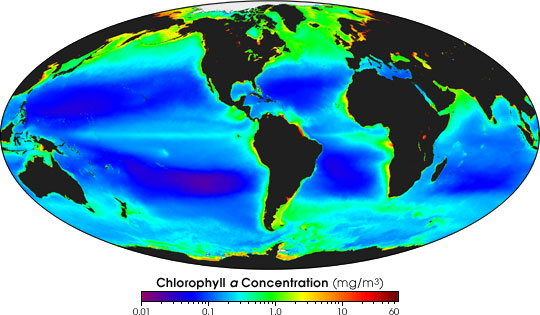6. Plankton Blooms
Changes through the year (1/2)
Global average
The image below is the average ocean chlorophyll concentration measured by the ocean colour sensor SeaWiFS on SeaStar from 1997 to 2004. There is a close relationship between physical and chemical ocean processes - like temperature differences and nutrient upwelling from the deep ocean that happens near coastlines - and ocean plant life. See the tutorial on Ocean Currents for more details.

Source: NASA
As the image shows, chlorophyll (and therefore phytoplankton) concentrations are higher in coastal areas than they are in the open ocean. They also are higher in the northern oceans than the southern.
An image like this smooths out variations through the year and over the seven years of data. We can use daily, weekly and monthly images to look at variations on different time-scales. The other images on the page show the monthly chlorophyll concentrations for June, September, December 2007 and March 2008.
The animation to the right shows a time series of all the monthly images from June 2007 to June 2008.
See the links page for more animations on plankton bloom dynamics.
From season to season
Some of the changes through the year are linked to the way the ocean circulation varies, others to the amount of light available. These seasonal cycles result in characteristic seasonal variations in different parts of the oceans. The satellite images on this page show these variations clearly in some regions, particularly the North Atlantic and near the Equator.
Spring bloom
During the winter, waters in the high latitude oceans are cold at the surface. The temperature difference between surface waters and deep waters is small, and the water can mix vertically. Rising deep water brings nutrients to the surface. So when the amount of light available increases with the spring, the surface waters have both light and nutrients, and phytoplankton thrive. As the available nutrients are used up and also as the phytoplankton are eaten by zooplankton, the annual bloom fades away until the right conditions return the next year.
Ocean colour data from the MODIS sensor on the NASA Aqua satellite.
Source: NASA
Equatorial upwelling
Nutrients can also be brought to the surface waters by upwelling, which often occurs along coasts and is also important near the equator. The images show a second global pattern in chlorophyll near the Equator, particularly in the Pacific Ocean. A turquoise streak along the Equator shows that phytoplankton were growing. Surface waters are pushed away from the Equator by the prevailing winds and cooler water with a higher nutrient content rises to replace it.
East-blowing winds along the Equator push water North in the Northern Hemisphere, and South in the Southern Hemisphere. See the Ocean Currents tutorial for more details.
